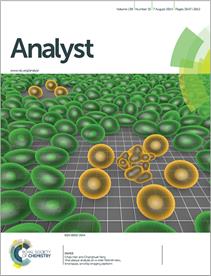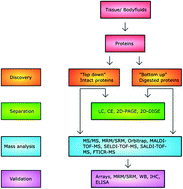Take a look at our recent HOT Analyst articles, these are now free to access for the next few weeks!
A label-free activatable aptamer probe for colorimetric detection of cancer cells based on binding-triggered in situ catalysis of split DNAzyme
Hui Shi, Duo Li, Fengzhou Xu, Xiaoxiao He, Kemin Wang, Xiaosheng Ye, Jinlu Tang and Chunmei He
Analyst, 2014,139, 4181-4184
DOI: 10.1039/C4AN00561A, Communication
A three-dimensional interpenetrating electrode of reduced graphene oxide for selective detection of dopamine
Xiaowen Yu, Kaixuan Sheng and Gaoquan Shi
Analyst, 2014,139, 4525-4531
DOI: 10.1039/C4AN00604F, Paper
Fine structural features of nanoscale zero-valent iron characterized by spherical aberration corrected scanning transmission electron microscopy (Cs-STEM)
Airong Liu and Wei-xian Zhang
Analyst, 2014,139, 4512-4518
DOI: 10.1039/C4AN00679H, Paper
On-chip monitoring of skeletal myoblast transplantation for the treatment of hypoxia-induced myocardial injury
Juan He, Chao Ma, Wenming Liu and Jinyi Wang
Analyst, 2014,139, 4482-4490
DOI: 10.1039/C4AN00697F, Paper
Global in vivo terminal amino acid labeling for exploring differential expressed proteins induced by dialyzed serum cultivation
Li-Qi Xie, Ai-Ying Nie, Shu-Jun Yang, Chao Zhao, Lei Zhang, Peng-Yuan Yang and Hao-Jie Lu
Analyst, 2014,139, 4497-4504
DOI: 10.1039/C4AN00728J, Paper
A novel variable selection approach that iteratively optimizes variable space using weighted binary matrix sampling
Bai-chuan Deng, Yong-huan Yun, Yi-zeng Liang and Lun-zhao Yi
Analyst, 2014, Advance Article
DOI: 10.1039/C4AN00730A, Paper
Using electron paramagnetic resonance to map N@C60 during high throughput processing
Simon R. Plant and Kyriakos Porfyrakis
Analyst, 2014,139, 4519-4524
DOI: 10.1039/C4AN00734D, Paper
Affinity-based precipitation via a bivalent peptidic hapten for the purification of monoclonal antibodies
Michael W. Handlogten, Jared F. Stefanick, Peter E. Deak and Basar Bilgicer
Analyst, 2014,139, 4247-4255
DOI: 10.1039/C4AN00780H, Paper
Real-time detection of metal ions using conjugated polymer composite papers
Ji Eun Lee, Hyeon Woo Shim, Oh Seok Kwon, Yang-Il Huh and Hyeonseok Yoon
Analyst, 2014,139, 4466-4475
DOI: 10.1039/C4AN00804A, Paper
Identification and discrimination of binding sites of an organoruthenium anticancer complex to single-stranded oligonucleotides by mass spectrometry
Suyan Liu, Kui Wu, Wei Zheng, Yao Zhao, Qun Luo, Shaoxiang Xiong and Fuyi Wang
Analyst, 2014,139, 4491-4496
DOI: 10.1039/C4AN00807C, Paper
Simultaneous analysis of nanoparticles and small molecules by high-performance liquid chromatography using a silica monolithic column
Naoki Itoh, Akira Sano, Tomofumi Santa and Masaru Kato
Analyst, 2014,139, 4453-4457
DOI: 10.1039/C4AN00819G, Communication
Parameters affecting ion intensities in transmission-mode direct analysis in real-time mass spectrometry
Lindsay P. Harding, Gareth M. B. Parkes and James D. Townend
Analyst, 2014,139, 4176-4180
DOI: 10.1039/C4AN00859F, Communication
Simultaneous multiplexed quantification of nicotine and its metabolites using surface enhanced Raman scattering
Omar Alharbi, Yun Xu and Royston Goodacre
Analyst, 2014, Advance Article
DOI: 10.1039/C4AN00879K, Paper
A graphene oxide-based enzyme-free signal amplification platform for homogeneous DNA detection
Zhen Zhang, Yufei Liu, Xinghu Ji, Xia Xiang and Zhike He
Analyst, 2014, Advance Article
DOI: 10.1039/C4AN00933A, Paper
A spatiotemporally defined in vitro microenvironment for controllable signal delivery and drug screening
Ching-Te Kuo, Hao-Kai Liu, Guan-Syuan Huang, Chi-Hao Chang, Chen-Lin Chen, Ken-Chao Chen, Ruby Yun-Ju Huang, Ching-Hung Lin, Hsinyu Lee, Chiun-Sheng Huang and Andrew M. Wo
Analyst, 2014, Advance Article
DOI: 10.1039/C4AN00936C, Paper
Detection of strep throat causing bacterium directly from medical swabs by touch spray-mass spectrometry
Alan K. Jarmusch, Valentina Pirro, Kevin S. Kerian and R. Graham Cooks
Analyst, 2014, Advance Article
DOI: 10.1039/C4AN00959B, Communication
A rapid method to estimate the concentration of citrate capped silver nanoparticles from UV-visible light spectra
D. Paramelle, A. Sadovoy, S. Gorelik, P. Free, J. Hobley and D. G. Fernig
Analyst, 2014, Advance Article
DOI: 10.1039/C4AN00978A, Paper
Diagnosing malaria infected cells at the single cell level using focal plane array Fourier transform infrared imaging spectroscopy
Bayden R. Wood, Keith. R. Bambery, Matthew W. A. Dixon, Leann Tilley, Michael J. Nasse, Eric Mattson and Carol J. Hirschmugl
Analyst, 2014, Advance Article
DOI: 10.1039/C4AN00989D, Communication
A napthelene–pyrazol conjugate: Al(III) ion-selective blue shifting chemosensor applicable as biomarker in aqueous solution
Manjira Mukherjee, Siddhartha Pal, Somenath Lohar, Buddhadeb Sen, Supriti Sen, Samya Banerjee, Snehasis Banerjee and Pabitra Chattopadhyay
Analyst, 2014, Advance Article
DOI: 10.1039/C4AN01039F, Paper
Microfluidic device with tunable post arrays and integrated electrodes for studying cellular release
Asmira Selimovic, Jayda L. Erkal, Dana M. Spence and R. Scott Martin
Analyst, 2014, Advance Article
DOI: 10.1039/C4AN01062K, Paper
High efficiency tandem mass spectrometry analysis using dual linear ion traps
Linfan Li, Xiaoyu Zhou, James W. Hager and Zheng Ouyang
Analyst, 2014, Advance Article
DOI: 10.1039/C4AN01070A, Communication
Detection of counterfeit electronic components through ambient mass spectrometry and chemometrics
Kevin P. Pfeuffer, Jack Caldwell, Jake T. Shelley, Steven J. Ray and Gary M. Hieftje
Analyst, 2014,139, 4505-4511
DOI: 10.1039/C4AN01071J, Paper
Hydroxylated near-infrared BODIPY fluorophores as intracellular pH sensors
Mohamed M. Salim, Eric A. Owens, Tielong Gao, Jeong Heon Lee, Hoon Hyun, Hak Soo Choi and Maged Henary
Analyst, 2014, Advance Article
DOI: 10.1039/C4AN01104J, Paper
An inkjet-printed bioactive paper sensor that reports ATP through odour generation
Zhuyuan Zhang, Jingyun Wang, Robin Ng, Yingfu Li, Zaisheng Wu, Vincent Leung, Spencer Imbrogno, Robert Pelton, John D. Brennan and Carlos D. M. Filipe
Analyst, 2014, Advance Article
DOI: 10.1039/C4AN01113A, Communication















